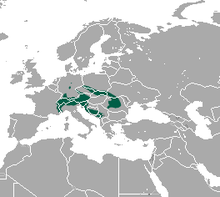Alpine shrew
| Alpine shrew | |
|---|---|
| Scientific classification | |
| Domain: | Eukaryota |
| Kingdom: | Animalia |
| Phylum: | Chordata |
| Class: | Mammalia |
| Order: | Eulipotyphla |
| Family: | Soricidae |
| Genus: | Sorex |
| Species: | S. alpinus
|
| Binomial name | |
| Sorex alpinus Schinz,1837
| |

| |
| Alpine Shrew range | |
Thealpine shrew(Sorex alpinus) is aspeciesofmammalin the familySoricidae.It is found in the alpine meadows and coniferous forests of central and southern European mountain ranges.
Description
[edit]The Alpine shrew is 6 to 7.7 centimetres (2.4 to 3.0 in) in length, not including a tail as long as its body, and weighs between 5.5 and 11.5 g (0.2 and 0.4 oz). It is a uniform greyish-black on its dorsal (upper) surface and greyish-brown on its underparts. The tips of its teeth are reddish-brown and it has a long pointed snout, small black eyes and rounded pink ears. Its legs and feet are white and the underside of its hairy tail is yellowish.[2]Juveniles are somewhat paler than adults.[3]It shares its range with the common shrewSorex araneusand the Eurasian pygmy shrewSorex minutusbut is distinguishable from these by its darker fur and longer tail.[2]
Distribution and habitat
[edit]The Alpine shrew is found in the mountains and uplands of Central and Eastern Europe and parts of France. Its range includes theAlps,theBlack Forest,theJura Mountains,the mountains of southern Germany, theGiant Mountains,theBeskids,theTatra Mountains,theCarpathian Mountains,theTransylvanian Alps,the uplands ofVosgesand the mountains of the former Yugoslavia. The Alpine shrew is found inAlpine meadowsand in coniferous woodland at elevations between about 200 and 2,500 metres (660 and 8,200 ft).[3]It sometimes occurs above thetree linebut more normally favours damp pastures and swampy ground near small streams in areas with dwarf sparse conifers near the upper limit of tree cover.[3]It tends to lurk in dense vegetation, occupies rock crevices and lives under boulders or fallen branches and often occurs nearmountain huts.[3]
The Alpine shrew was recorded in theSpanishPyreneesin the early 20th century. It is presumedlocally extinctdue to the lack of modern sightings.[4]
Behaviour
[edit]The Alpine shrew is nocturnal and is a skilled climber, using its tail for balance. It uses scent glands on itsflanksto mark itsterritory.Like other shrew species, it has a high metabolic rate and needs to feed frequently. It eatsinsects,spiders,snailsandearthwormsand is in turn thepreyoffoxes,weasels,domestic catsandtawny owls.[2]
Status
[edit]The Alpine shrew is listed as "Near Threatened"in theIUCN'sRed List of Threatened Species.This is because it occupies a number of separate,disjunctmountain regions and seems to be slowly declining in numbers. It may be threatened byhabitat destructionas hydro-electric schemes and increased tourism impact its environment. It used to be present in the Pyrenees but has not been seen there for many years and may be extinct there, nor has it been seen recently in theHarz Mountainregion of Germany.[1]
References
[edit]- ^abMeinig, H.; Bertolino, S.; zima, j. (2020)."Sorex alpinus".IUCN Red List of Threatened Species.2020:e.T29660A114024313.doi:10.2305/IUCN.UK.2020-2.RLTS.T29660A114024313.en.Retrieved16 November2021.
- ^abcBurke, Felicity (2011)."Sorex alpinus:Alpine shrew ".Animal Diversity Web.University of Michigan.Retrieved2013-08-21.
- ^abcdKonig, Claus (1973).Mammals.Collins & Co. pp. 22–23.ISBN978-0-00-212080-7.
- ^Palomo, L. J., Gisbert, J., & Blanco, J. C. (Eds.). (2007). Atlas y libro rojo de los mamíferos terrestres de España. Madrid: Organismo Autónomo de Parques Nacionales.

